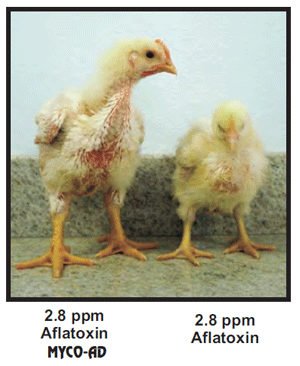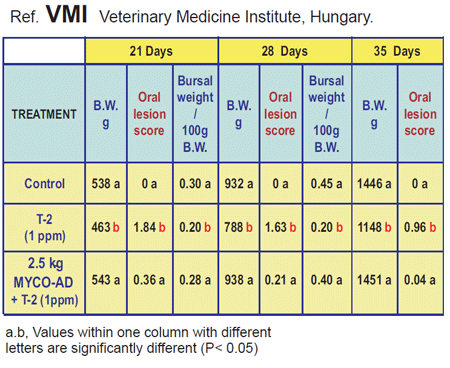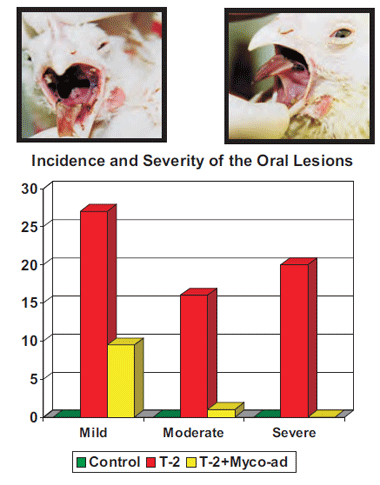TARGET ORGANS - The key to an effective mycotoxins adsorbent
Published: February 24, 2009
By: Special Nutrients Inc.
Poultry, swine and dairy producers admit today that the presence of mycotoxins in the feed is one of the main factors affecting animal production. As a result of the higher prices of feed ingredients, their quality is getting worse, with some grains showing higher levels of mycotoxins. High contamination levels can also be found in distillers grains, an ingredient in increasing supply, originated from the use of corn in ethanol production in the US.
Some producers consider that mycotoxins are becoming as important as bacterial and viral diseases. This attitude represents a completely different approach to the importance given to mycotoxins in 1987 when we worked with the group lunching the first mycotoxins adsorbent into the global market. At that time most growers considered that mycotoxins did not represent a serious problem.
We should point out that nowadays there are still some producers that confuse mycotoxicosis with viral and bacterial diseases. Part of this problem is due to the lack of access to good diagnostic techniques like histopathology, an excellent tool for the confirmation of the diagnosis. It is important to emphasize that as part of the evaluation of the first absorbents, a key factor in that evaluation was to demonstrate protection of target organs. Table 1 shows the organs most affected by different mycotoxins.
In today's market there has been an influx of products claiming to be effective in controlling the deleterious effects caused by mycotoxins. Some of these products base its effectiveness on marketing campaigns without showing in vitro and/or in vivo results to backup their claims. Some base their efficacy only on in vitro tests or on a positive effect on performance (often without any statistical significant differences) and others on some improvement of the immune response.
Sometimes these positive effects are obtained because of the presence of yeast, beneficial bacteria, enzymes and/or immuno-modulators that are added to the mycotoxins absorbents. These ingredients act to alleviate the secondary effects caused by mycotoxins but have little or no effect on the target organs. Unfortunately few products in the global market have a proven efficacy on the main target organs affected by the mycotoxins against which they are tested.
For the last 2 years the Brazilian government has taken a scientific approach on the approval of mycotoxin binders by evaluating the presence or absence of a statistically significant effect on target organs. LAMIC (Laboratorio de Analisis Micotoxicologicos), under the direction of Dr. Carlos Mallmann, is one key laboratory in charge of this type of tests. So far, few products have passed this strict test (most for aflatoxin) which must be repeated every two years, to demonstrate the product maintains its efficacy. As a result of this novel approach by the Brazilian government, companies are obliged to test their products at LAMIC which now has become one of the top reference laboratories in the world.
If a company claims in his marketing campaign that any of his products has been tested by LAMIC, it does not mean that the absorbent has been approved. Sometimes the results obtained show an improvement in performance, but it is not necessarily related to the protection of the target organs. If any product indicates or suggests a LAMIC approval, it is highly recommendable that you ask for the original study and look at the end of it for a written statement in Portuguese indicating that the product is approved for a 2 - year period.
TARGET ORGAN

Few products have scientific trials showing a positive effect on target organsto support their claims. The following table shows a list of the scientific trials performed with MYCO-AD and MYCO-AD A-Z by
independent Universities and Research Centers around the world.


AFLATOXIN
MYCO-AD effect on liver and size of broilers fed 2.8 ppm of Aflatoxin.



OCHRATOXIN
MYCO-AD effect on liver and kidney size, and presence of lesions in 28 day-old broilers fed 2 ppm of Ochratoxin.

T-2 TOXIN
MYCO-AD effect on body weight, oral lesions and bursa weight of broilers fed 1 ppm of T-2 toxin at different ages



Some producers consider that mycotoxins are becoming as important as bacterial and viral diseases. This attitude represents a completely different approach to the importance given to mycotoxins in 1987 when we worked with the group lunching the first mycotoxins adsorbent into the global market. At that time most growers considered that mycotoxins did not represent a serious problem.
We should point out that nowadays there are still some producers that confuse mycotoxicosis with viral and bacterial diseases. Part of this problem is due to the lack of access to good diagnostic techniques like histopathology, an excellent tool for the confirmation of the diagnosis. It is important to emphasize that as part of the evaluation of the first absorbents, a key factor in that evaluation was to demonstrate protection of target organs. Table 1 shows the organs most affected by different mycotoxins.
In today's market there has been an influx of products claiming to be effective in controlling the deleterious effects caused by mycotoxins. Some of these products base its effectiveness on marketing campaigns without showing in vitro and/or in vivo results to backup their claims. Some base their efficacy only on in vitro tests or on a positive effect on performance (often without any statistical significant differences) and others on some improvement of the immune response.
Sometimes these positive effects are obtained because of the presence of yeast, beneficial bacteria, enzymes and/or immuno-modulators that are added to the mycotoxins absorbents. These ingredients act to alleviate the secondary effects caused by mycotoxins but have little or no effect on the target organs. Unfortunately few products in the global market have a proven efficacy on the main target organs affected by the mycotoxins against which they are tested.
For the last 2 years the Brazilian government has taken a scientific approach on the approval of mycotoxin binders by evaluating the presence or absence of a statistically significant effect on target organs. LAMIC (Laboratorio de Analisis Micotoxicologicos), under the direction of Dr. Carlos Mallmann, is one key laboratory in charge of this type of tests. So far, few products have passed this strict test (most for aflatoxin) which must be repeated every two years, to demonstrate the product maintains its efficacy. As a result of this novel approach by the Brazilian government, companies are obliged to test their products at LAMIC which now has become one of the top reference laboratories in the world.
If a company claims in his marketing campaign that any of his products has been tested by LAMIC, it does not mean that the absorbent has been approved. Sometimes the results obtained show an improvement in performance, but it is not necessarily related to the protection of the target organs. If any product indicates or suggests a LAMIC approval, it is highly recommendable that you ask for the original study and look at the end of it for a written statement in Portuguese indicating that the product is approved for a 2 - year period.
TARGET ORGAN

Few products have scientific trials showing a positive effect on target organsto support their claims. The following table shows a list of the scientific trials performed with MYCO-AD and MYCO-AD A-Z by
independent Universities and Research Centers around the world.


AFLATOXIN
MYCO-AD effect on liver and size of broilers fed 2.8 ppm of Aflatoxin.


OCHRATOXIN
MYCO-AD effect on liver and kidney size, and presence of lesions in 28 day-old broilers fed 2 ppm of Ochratoxin.

T-2 TOXIN
MYCO-AD effect on body weight, oral lesions and bursa weight of broilers fed 1 ppm of T-2 toxin at different ages



Related topics:
Authors:
Special Nutrients
Recommend
Comment
Share
Special Nutrients
20 de diciembre de 2011
Our Agent in Egypt is Taba Medical supply and MYCOAD in Egypt is sold under the name TX-FREE
Recommend
Reply
Fast Feed Mills
1 de abril de 2009
The know how about mycotoxin in our region meant especially for aflatoxin only. Informative as well as detailed article.
Recommend
Reply
Special Nutrients
2 de marzo de 2009
Dear Dr Iftikhar:
Thank you for bringing to our attention the typing error. Yes, you are correct, it should indicated 2.8 ppm, instead of 2.8 ppb.
If we can be of further assistance, please let us know.
Regards,
Fernando Tamames III
Recommend
Reply
Recommend
Reply
24 de febrero de 2009
An article depicting the role of Myco Ad and its binding spectrum for mycotoxin needs correction in column graph showing The relative weight of liver showing the units ppb (2.8 ppb) which I think should be ppm. Pl correct or mention whether it is right.
Recommend
Reply

Would you like to discuss another topic? Create a new post to engage with experts in the community.










.jpg&w=3840&q=75)